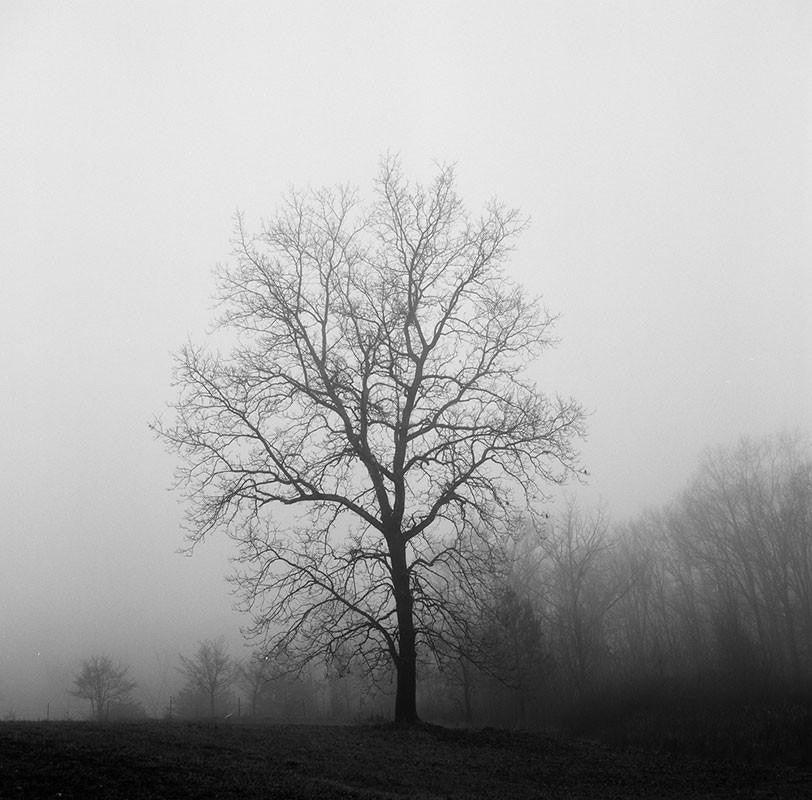
I've seen a lot of very popular landscape photographers on YouTube demonstrating their photography techniques. Most often, this amounts to hiking up a mountain with a tripod and a backpack full of lenses, filters, and other gadgets with the goal of clicking a few shots of the setting sun. Episode after episode, more sunsets. If the sky is cloudy, or even worse, if there's a fog, the day is a total loss.
For me, landscape photography is a much different experience. Sure, I love a beautiful sunset, but as a photographer who specializes in black and white exclusively, I have a different take on things. One of my very distinct departures from the apparent norm, is that I prefer shooting on cloudy, foggy, rainy or otherwise gloomy days, especially in winter. (I also prefer a much more diverse set of subject matter, but that's a topic for another day.) But why would a photographer prefer shooting in winter, when the weather sucks and everything is dead?
Here are the top reasons why I prefer photographing the landscape in winter.
- I prefer winter light
- Shooting at midday
- I like the mood of the winter landscape
- No mosquitoes, ticks, or snakes (or bears)
- Less crowded locations
My rationales
I prefer winter light
First and foremost, I prefer the light and landscape in winter. Remember, I specialize in black and white photography. For color photography, shooting in winter is a whole different situation. Having said that, I prefer winter light because it's softer. Winter light is less direct and winter skies are more likely to be cloudy — even gloomy — which opens shadows and eases highlights. That gives me much more control over the contrast. There are days with soft light from cloudy skies in summer, they're just less frequent.
I was raised in Texas, and I currently live in the southeastern US where summer light can be very harsh — even glaring. Even at the golden hour, the light can still be very contrasty. Northern light has a different quality, as does the light in certain other places like New Mexico. Even in summer, northern light is often filtered in a way I rarely see down south. This leads to reason number two on why I prefer shooting in winter.
Shooting anytime of day
Soft, cloudy winter light allows me to shoot at any time of day, even midday. Of course, days are shorter in winter, which makes it more important to have those midday hours available for shooting. Inclement weather, gloomy skies, and barren landscapes also add to the dark mood I look for in my work. I'm not trying to shoot a vacation postcard; I'm trying to convey emotion. Which leads me to reason number three.
I like the mood of the winter landscape
For me, as a black and white photographer, the winter landscape is just so beautiful. I love the bare bone structure of leafless trees. I love the texture of a winter sky. I love the ice patterns, raindrops, and structures of the landscape in the middle of winter when it's most exposed. The landscape has moods, and I love the mood of the winter landscape. Nasty weather adds visual drama. Does this mean I don't enjoy a walk in the park on a beautiful spring day? Of course not! I love spring as much as the next romantic, but, for me, it's less fun to photograph. Did I mention that snow is always lovely?
No mosquitoes, ticks, or snakes
Cold weather means I don't have to slather my body in a toxic sludge of sunscreen and bug spray. I don't enjoy the feeling or odor of sunscreen and insect spray, either together or separately. If I can avoid them, it's a big plus for me. In summer, I keep hand wipes in my kit to cleanse the greasy film from my hands before touching the gear. In winter, biting insects are less likely, as is an encounter with rattlesnakes, copperheads, and cottonmouth snakes (not to mention bears, scorpions, spiders, etc.)
Of course, cold weather does mean the addition of bulky winter clothing and potential battery drain. Everything is a trade-off, but this is a trade-off I'm willing to make.
Less crowded locations
I once visited Mt. Rushmore on New Year's Day. The weather was beautiful but it was an extremely cold day, which meant there were less than a dozen people in the entire park, including the rangers. I visited the Dakota Badlands on the same trip and again, the park was virtually empty. I don't mind the cold, but I do mind crowds, especially when I'm focused on photography. Shooting in winter means that I quite often have locations all to myself. Not only does this mean fewer people, but it also means snow-covered fields with no footprints across them, landscape photographs with no tourists in the shot, and the ability to work unimpeded and unhurried.
On the flip side, many attractions are closed (or partially closed) in winter, especially in the north. Even at Rushmore, parts of the site were not open due to holiday hours or the season. Usually, I don't mind if museums or other "attractions" are closed, as long as I'm able to access the places I want to photograph. In the northern mountain states (Wyoming and Montana for example) entire stretches of road can be closed for the winter, which is very inconvenient and requires advance planning, safety precautions, and a certain amount of flexibility. And those roads can stay closed into April.
Those are my reasons for preferring landscape photography in winter. Of course, I shoot at any opportunity, regardless of the time of year. And I do occasionally focus my lens on a lovely sunset, even if it's just for Instagram.





Leave a comment